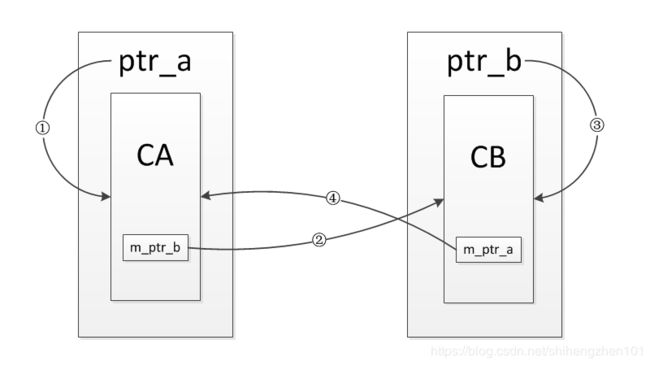C++11智能指针(unique_ptr、shared_ptr、weak_ptr)
更多文章欢迎访问 程序员小非 博客
很多人怕写C/C++ 程序就是因为指针,因为指针给了程序员高度的自由,同样也赋予了高度的责任,稍有不慎就导致内存泄漏。其实写C++ 可以完全不用指针,尤其C++ 11对智能指针作了进一步的升级,在不需要使用任何裸指针的前提下也可以写出高效的C++ 程序。C++ 11中定义了unique_ptr、shared_ptr与weak_ptr三种智能指针(smart pointer),都包含在
unique_ptr
如名字所示,unique_ptr是个独占指针,C++ 11之前就已经存在,unique_ptr所指的内存为自己独有,某个时刻只能有一个unique_ptr指向一个给定的对象,不支持拷贝和赋值。下面以代码样例来说明unique_ptr的用法,各种情况都在代码注释给出。
#include up2 = up1; // err, 不能通过编译
std::cout << *up1 << std::endl; // 11
std::unique_ptr<int> up3 = std::move(up1); // 现在p3是数据的唯一的unique_ptr
std::cout << *up3 << std::endl; // 11
// std::cout << *up1 << std::endl; // err, 运行时错误,空指针
up3.reset(); // 显式释放内存
up1.reset(); // 不会导致运行时错误
// std::cout << *up3 << std::endl; // err, 运行时错误,空指针
std::unique_ptr<int> up4(new int(22)); // 无法复制的unique_ptr
up4.reset(new int(44)); // "绑定"动态对象
std::cout << *up4 << std::endl; // 44
up4 = nullptr; // 显式销毁所指对象,同时智能指针变为空指针。与up4.reset()等价
std::unique_ptr<int> up5(new int(55));
int *p = up5.release(); // 只是释放控制权,不会释放内存
std::cout << *p << std::endl;
// cout << *up5 << endl; // err, 运行时错误,不再拥有内存
delete p; // 释放堆区资源
return;
}
shared_ptr
shared_ptr允许多个该智能指针共享“拥有”同一堆分配对象的内存,这通过引用计数(reference counting)实现,会记录有多少个shared_ptr共同指向一个对象,一旦最后一个这样的指针被销毁,也就是一旦某个对象的引用计数变为0,这个对象会被自动删除。支持复制和赋值操作。
#include 除了上面出现的use_count和reset之外,还有unique返回是否是独占所有权(use_count 为 1),swap交换两个shared_ptr对象(即交换所拥有的对象),get返回内部对象(指针)几个成员函数。
- make_shared 函数
最安全的分配和使用动态内存的方法是调用一个名为make_shared的标准库函数。此函数在动态内存中分配一个对象并初始化它,返回指向此对象的shared_ptr。当要用make_shared时,必须指定想要创建的对象的类型或者使用更为简洁的auto,如下:
// 指向一个值为42的int的shared_ptr
shared_ptr<int> p3 = make_shared<int>(42);
// p4指向一个值为"9999999999"的string
shared_ptr<string> p4 = make_shared<string>(10,'9');
// p5指向一个值初始化的int,值为0
shared_ptr<int> p5 = make_shared<int>();
// p6指向一个动态分配的空vector- 当进行拷贝或赋值操作时,每个
shared_ptr都会记录有多少个其他shared_ptr指向相同的对象:
auto p = make_shared<int>(42); //p指向的对象只有p一个引用者
auto q(p); //p和q指向相同对象,此对象有两个引用者
weak_ptr
weak_ptr是为配合shared_ptr而引入的一种智能指针来协助shared_ptr工作,它可以从一个shared_ptr或另一个weak_ptr对象构造,它的构造和析构不会引起引用计数的增加或减少。没有重载 *和 -> 但可以使用lock获得一个可用的shared_ptr对象
weak_ptr的使用更为复杂一点,它可以指向shared_ptr指针指向的对象内存,却并不拥有该内存,而使用weak_ptr成员lock,则可返回其指向内存的一个share_ptr对象,且在所指对象内存已经无效时,返回指针空值nullptr。
注意:weak_ptr并不拥有资源的所有权,所以不能直接使用资源。 可以从一个weak_ptr构造一个shared_ptr以取得共享资源的所有权。
#include 所指对象
std::cout << "count: " << wp.use_count() << std::endl; // count: 2
std::cout << *sp1 << std::endl; // 22
std::cout << *sp2 << std::endl; // 22
check(wp); // still: 22
sp1.reset();
std::cout << "count: " << wp.use_count() << std::endl; // count: 1
std::cout << *sp2 << std::endl; // 22
check(wp); // still: 22
sp2.reset();
std::cout << "count: " << wp.use_count() << std::endl; // count: 0
check(wp); // still: pointer is invalid
return;
}
- 为什么要使用weak_ptr
weak_ptr解决shared_ptr循环引用的问题
定义两个类,每个类中又包含一个指向对方类型的智能指针作为成员变量,然后创建对象,设置完成后查看引用计数后退出,看一下测试结果:
class CB;
class CA
{
public:
CA() { cout << "CA() called! " << endl; }
~CA() { cout << "~CA() called! " << endl; }
void set_ptr(shared_ptr<CB>& ptr) { m_ptr_b = ptr; }
void b_use_count() { cout << "b use count : " << m_ptr_b.use_count() << endl; }
void show() { cout << "this is class CA!" << endl; }
private:
shared_ptr<CB> m_ptr_b;
};
class CB
{
public:
CB() { cout << "CB() called! " << endl; }
~CB() { cout << "~CB() called! " << endl; }
void set_ptr(shared_ptr<CA>& ptr) { m_ptr_a = ptr; }
void a_use_count() { cout << "a use count : " << m_ptr_a.use_count() << endl; }
void show() { cout << "this is class CB!" << endl; }
private:
shared_ptr<CA> m_ptr_a;
};
void test_refer_to_each_other()
{
shared_ptr<CA> ptr_a(new CA());
shared_ptr<CB> ptr_b(new CB());
cout << "a use count : " << ptr_a.use_count() << endl;
cout << "b use count : " << ptr_b.use_count() << endl;
ptr_a->set_ptr(ptr_b);
ptr_b->set_ptr(ptr_a);
cout << "a use count : " << ptr_a.use_count() << endl;
cout << "b use count : " << ptr_b.use_count() << endl;
}
// 测试结果
CA() called!
CB() called!
a use count : 1
b use count : 1
a use count : 2
b use count : 2
通过结果可以看到,最后CA和CB的对象并没有被析构,其中的引用效果如下图所示,起初定义完ptr_a和ptr_b时,只有①③两条引用,然后调用函数set_ptr后又增加了②④两条引用,当test_refer_to_each_other这个函数返回时,对象ptr_a和ptr_b被销毁,也就是①③两条引用会被断开,但是②④两条引用依然存在,每一个的引用计数都不为0,结果就导致其指向的内部对象无法析构,造成内存泄漏。

解决这种状况的办法就是将两个类中的一个成员变量改为weak_ptr对象,因为weak_ptr不会增加引用计数,使得引用形不成环,最后就可以正常的释放内部的对象,不会造成内存泄漏,比如将CB中的成员变量改为weak_ptr对象,代码如下:
class CB
{
public:
CB() { cout << "CB() called! " << endl; }
~CB() { cout << "~CB() called! " << endl; }
void set_ptr(shared_ptr<CA>& ptr) { m_ptr_a = ptr; }
void a_use_count() { cout << "a use count : " << m_ptr_a.use_count() << endl; }
void show() { cout << "this is class CB!" << endl; }
private:
weak_ptr<CA> m_ptr_a;
};
// 测试结果
CA() called!
CB() called!
a use count : 1
b use count : 1
a use count : 1
b use count : 2
~CA() called!
~CB() called!
通过这次结果可以看到,CA和CB的对象都被正常的析构了,引用关系如下图所示,流程与上一例子相似,但是不同的是④这条引用是通过weak_ptr建立的,并不会增加引用计数,也就是说CA的对象只有一个引用计数,而CB的对象只有2个引用计数,当test_refer_to_each_other这个函数返回时,对象ptr_a和ptr_b被销毁,也就是①③两条引用会被断开,此时CA对象的引用计数会减为0,对象被销毁,其内部的m_ptr_b成员变量也会被析构,导致CB对象的引用计数会减为0,对象被销毁,进而解决了引用成环的问题。

- weak_ptr 注意事项
// 编译错误 // error C2665: “std::weak_ptr::weak_ptr”: 3 个重载中没有一个可以转换所有参数类型
// weak_ptr ptr_1(new CA());
// 编译错误
// error C2440 : “初始化”: 无法从“std::weak_ptr”转换为“std::shared_ptr”
// shared_ptr ptr_3 = wk_ptr;
// 编译错误
// 编译必须作用于相同的指针类型之间
// wk_ptr_a.swap(wk_ptr_b); // 调用交换函数
// 编译错误
// 编译必须作用于相同的指针类型之间
// wk_ptr_b = wk_ptr_a;
weak_ptr中只有函数lock和expired两个函数比较重要,因为它本身不会增加引用计数,所以它指向的对象可能在它用的时候已经被释放了,所以在用之前需要使用expired函数来检测是否过期,然后使用lock函数来获取其对应的shared_ptr对象,然后进行后续操作:
void test2()
{
shared_ptr<CA> ptr_a(new CA()); // 输出:CA() called!
shared_ptr<CB> ptr_b(new CB()); // 输出:CB() called!
cout << "ptr_a use count : " << ptr_a.use_count() << endl; // 输出:ptr_a use count : 1
cout << "ptr_b use count : " << ptr_b.use_count() << endl; // 输出:ptr_b use count : 1
weak_ptr<CA> wk_ptr_a = ptr_a;
weak_ptr<CB> wk_ptr_b = ptr_b;
if (!wk_ptr_a.expired())
{
wk_ptr_a.lock()->show(); // 输出:this is class CA!
}
if (!wk_ptr_b.expired())
{
wk_ptr_b.lock()->show(); // 输出:this is class CB!
}
wk_ptr_b.reset(); // 将wk_ptr_b的指向清空
if (wk_ptr_b.expired())
{
cout << "wk_ptr_b is invalid" << endl; // 输出:wk_ptr_b is invalid 说明改指针已经无效
}
wk_ptr_b = ptr_b;
if (!wk_ptr_b.expired())
{
wk_ptr_b.lock()->show(); // 输出:this is class CB! 调用赋值操作后,wk_ptr_b恢复有效
}
// 最后输出的引用计数还是1,说明之前使用weak_ptr类型赋值,不会影响引用计数
cout << "ptr_a use count : " << ptr_a.use_count() << endl; // 输出:ptr_a use count : 1
cout << "ptr_b use count : " << ptr_b.use_count() << endl; // 输出:ptr_b use count : 1
}
OK,三个智能指针,鼓捣明白了吗?
